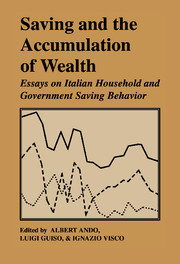Book contents
- Frontmatter
- Contents
- Foreword by Antonio Fazio
- List of contributors
- List of figures
- List of tables
- Acknowledgments
- Introduction
- I Saving trends, government deficit and demographic changes
- II Life-cycle saving and precautionary motives
- 5 Young households' saving and the life cycle of opportunities. Evidence from Japan and Italy
- 6 Dissaving by the elderly, transfer motives and liquidity constraints
- 7 Earnings uncertainty and precautionary saving
- 8 Risk sharing and precautionary saving
- III Borrowing constraints, intergenerational transfers and bequests
- Appendixes
- Index
8 - Risk sharing and precautionary saving
Published online by Cambridge University Press: 05 May 2010
- Frontmatter
- Contents
- Foreword by Antonio Fazio
- List of contributors
- List of figures
- List of tables
- Acknowledgments
- Introduction
- I Saving trends, government deficit and demographic changes
- II Life-cycle saving and precautionary motives
- 5 Young households' saving and the life cycle of opportunities. Evidence from Japan and Italy
- 6 Dissaving by the elderly, transfer motives and liquidity constraints
- 7 Earnings uncertainty and precautionary saving
- 8 Risk sharing and precautionary saving
- III Borrowing constraints, intergenerational transfers and bequests
- Appendixes
- Index
Summary
Introduction
The recent theoretical literature has explored the effect of uncertainty on saving and asset accumulation. In principle, precautionary saving may explain some of the discrepancies between the predictions generated by the standard life–cycle model (without uncertainty) and the empirical evidence. For instance, life–span uncertainty may account for the fact that the rate of wealth decumulation after retirement is much slower than that predicted by the standard life–cycle model (Davies, 1981; Hurd, 1989); earnings uncertainty may explain the excess sensitivity of consumption to expected income fluctuations (Zeldes, 1989; Caballero, 1990); the interaction between borrowing constraints and earnings uncertainty may explain why consumption tracks income so closely over the individual life cycle (Deaton, 1991); the increase in social and private insurance arrangements may account for the reduction in private saving rates that took place in the eighties in most industrialized countries (Kotlikoff, 1989; Auerbach and Kotlikoff, 1989).
Simulations run by Skinner (1988), Zeldes (1989) and Caballero (1991) with reference to income risk suggest that precautionary saving may form a large share of total life–cycle saving. At the empirical level, however, very few studies have been devoted to establishing the existence of a precautionary motive for saving and on measuring its magnitude. Moreover, the few available empirical findings yield only mixed support for the theory. Friedman (1957) found that households in more risky occupations save more than those in safer occupations, but his finding is not supported by the more recent evidence provided by Skinner (1988).
- Type
- Chapter
- Information
- Saving and the Accumulation of WealthEssays on Italian Household and Government Saving Behavior, pp. 246 - 270Publisher: Cambridge University PressPrint publication year: 1994



